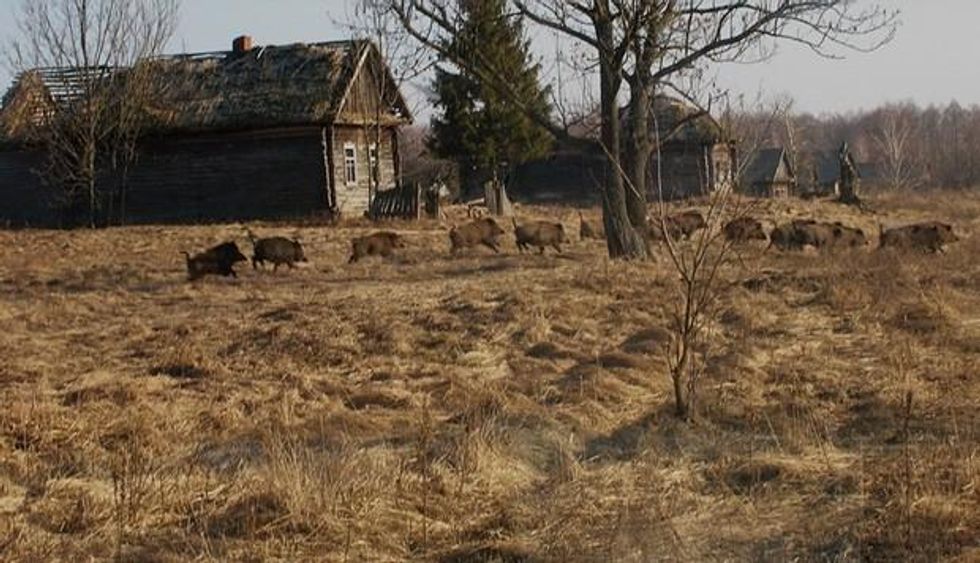Chernobyl Study: 'Amazing Illustration' of How Destructive Human Civilization Has Become
It upends common sense in many ways, but new research highlights how animal populations can thrive... when humans go away
If you think that life for a wild animal would be more horrendous and hazardous inside an "exclusionary zone" in the shadow of a melted-down nuclear plant than living in a world beset with deforestation, hunting and poaching, and the nearly non-stop encroachment of humanity's industrial expansion--a new study may have you thinking twice about such assumptions.
Published in the journal Current Biology on Monday, the new research shows that despite nearly three decades of living within the Belarus sector of the Chernobyl "exclusion" zone, the relative abundances of large mammals--including elk, dear and wild boar--are similar to those in four "uncontaminated" nature reserves in the region. Moreover, the study found, that the population of wolves was more than seven times higher inside the exclusion zone, compared to outside.
"[Our research] doesn't say that nuclear accidents aren't bad, of course they are. But it illustrates that the things we do everyday, the human population pressure, damages the environment. It's kind of obvious but it's an amazing illustration of it." --Prof. Jim Smith, University of PortsmouthAs the Guardian's reporting on the study notes, its findings run counter to previous hypothesises--not to mention everyday common sense--regarding how chronic long-term exposure to radiation might influence animal populations. But as Professor Jim Smith, professor of environmental science at the University of Portsmouth and one of the paper's authors, explained to the Guardian, the research findings do not show that living within a nuclear contamination zone is good, but simply highlights the widespread dangers and downward pressures contemporary society is having on the planet's wild mammal populations.
"What we do, our everyday habitation of an area - agriculture, forestry - they've damaged wildlife more than the world's worst nuclear accident," Smith explained. "It doesn't say that nuclear accidents aren't bad, of course they are. But it illustrates that the things we do everyday, the human population pressure, damages the environment. It's kind of obvious but it's an amazing illustration of it."

In response to Monday's release of the study, two other Chernobyl researchers-- Mike Wood of the University of Salford and Nick Beresford at the Centre for Ecology & Hydrology--wrote to say that though the work of Smith and his colleagues is a vital addition, much more research must be done to better understand the long-term impacts of various species exposed to such radiation. In their post on Gizmodo, Wood and Beresford explained:
While the study has shed much-needed light on wildlife in the area, further research is needed to verify the result and help us understand why this effect is seen.
For example, the finding goes against what may be expected to be seen: that ionising radiation is hazardous to living organisms. The results may even be taken to imply that raised radiation levels may have a beneficial effect on wildlife. However, it is important to keep in mind that as humans have left the zone, there is no agriculture, forestry or hunting to threaten wildlife. So radiation is most likely not good for animals, but removing humans definitely is.
There are likely to be negative effects of radiation in the exclusion zone. But currently we cannot clearly see this over the effects of humans leaving the area. For instance, the health or lifespan of the animals maybe affected and research is required to evaluate this.
An Urgent Message From Our Co-Founder
Dear Common Dreams reader, The U.S. is on a fast track to authoritarianism like nothing I've ever seen. Meanwhile, corporate news outlets are utterly capitulating to Trump, twisting their coverage to avoid drawing his ire while lining up to stuff cash in his pockets. That's why I believe that Common Dreams is doing the best and most consequential reporting that we've ever done. Our small but mighty team is a progressive reporting powerhouse, covering the news every day that the corporate media never will. Our mission has always been simple: To inform. To inspire. And to ignite change for the common good. Now here's the key piece that I want all our readers to understand: None of this would be possible without your financial support. That's not just some fundraising cliche. It's the absolute and literal truth. We don't accept corporate advertising and never will. We don't have a paywall because we don't think people should be blocked from critical news based on their ability to pay. Everything we do is funded by the donations of readers like you. Will you donate now to help power the nonprofit, independent reporting of Common Dreams? Thank you for being a vital member of our community. Together, we can keep independent journalism alive when it’s needed most. - Craig Brown, Co-founder |
If you think that life for a wild animal would be more horrendous and hazardous inside an "exclusionary zone" in the shadow of a melted-down nuclear plant than living in a world beset with deforestation, hunting and poaching, and the nearly non-stop encroachment of humanity's industrial expansion--a new study may have you thinking twice about such assumptions.
Published in the journal Current Biology on Monday, the new research shows that despite nearly three decades of living within the Belarus sector of the Chernobyl "exclusion" zone, the relative abundances of large mammals--including elk, dear and wild boar--are similar to those in four "uncontaminated" nature reserves in the region. Moreover, the study found, that the population of wolves was more than seven times higher inside the exclusion zone, compared to outside.
"[Our research] doesn't say that nuclear accidents aren't bad, of course they are. But it illustrates that the things we do everyday, the human population pressure, damages the environment. It's kind of obvious but it's an amazing illustration of it." --Prof. Jim Smith, University of PortsmouthAs the Guardian's reporting on the study notes, its findings run counter to previous hypothesises--not to mention everyday common sense--regarding how chronic long-term exposure to radiation might influence animal populations. But as Professor Jim Smith, professor of environmental science at the University of Portsmouth and one of the paper's authors, explained to the Guardian, the research findings do not show that living within a nuclear contamination zone is good, but simply highlights the widespread dangers and downward pressures contemporary society is having on the planet's wild mammal populations.
"What we do, our everyday habitation of an area - agriculture, forestry - they've damaged wildlife more than the world's worst nuclear accident," Smith explained. "It doesn't say that nuclear accidents aren't bad, of course they are. But it illustrates that the things we do everyday, the human population pressure, damages the environment. It's kind of obvious but it's an amazing illustration of it."

In response to Monday's release of the study, two other Chernobyl researchers-- Mike Wood of the University of Salford and Nick Beresford at the Centre for Ecology & Hydrology--wrote to say that though the work of Smith and his colleagues is a vital addition, much more research must be done to better understand the long-term impacts of various species exposed to such radiation. In their post on Gizmodo, Wood and Beresford explained:
While the study has shed much-needed light on wildlife in the area, further research is needed to verify the result and help us understand why this effect is seen.
For example, the finding goes against what may be expected to be seen: that ionising radiation is hazardous to living organisms. The results may even be taken to imply that raised radiation levels may have a beneficial effect on wildlife. However, it is important to keep in mind that as humans have left the zone, there is no agriculture, forestry or hunting to threaten wildlife. So radiation is most likely not good for animals, but removing humans definitely is.
There are likely to be negative effects of radiation in the exclusion zone. But currently we cannot clearly see this over the effects of humans leaving the area. For instance, the health or lifespan of the animals maybe affected and research is required to evaluate this.
If you think that life for a wild animal would be more horrendous and hazardous inside an "exclusionary zone" in the shadow of a melted-down nuclear plant than living in a world beset with deforestation, hunting and poaching, and the nearly non-stop encroachment of humanity's industrial expansion--a new study may have you thinking twice about such assumptions.
Published in the journal Current Biology on Monday, the new research shows that despite nearly three decades of living within the Belarus sector of the Chernobyl "exclusion" zone, the relative abundances of large mammals--including elk, dear and wild boar--are similar to those in four "uncontaminated" nature reserves in the region. Moreover, the study found, that the population of wolves was more than seven times higher inside the exclusion zone, compared to outside.
"[Our research] doesn't say that nuclear accidents aren't bad, of course they are. But it illustrates that the things we do everyday, the human population pressure, damages the environment. It's kind of obvious but it's an amazing illustration of it." --Prof. Jim Smith, University of PortsmouthAs the Guardian's reporting on the study notes, its findings run counter to previous hypothesises--not to mention everyday common sense--regarding how chronic long-term exposure to radiation might influence animal populations. But as Professor Jim Smith, professor of environmental science at the University of Portsmouth and one of the paper's authors, explained to the Guardian, the research findings do not show that living within a nuclear contamination zone is good, but simply highlights the widespread dangers and downward pressures contemporary society is having on the planet's wild mammal populations.
"What we do, our everyday habitation of an area - agriculture, forestry - they've damaged wildlife more than the world's worst nuclear accident," Smith explained. "It doesn't say that nuclear accidents aren't bad, of course they are. But it illustrates that the things we do everyday, the human population pressure, damages the environment. It's kind of obvious but it's an amazing illustration of it."

In response to Monday's release of the study, two other Chernobyl researchers-- Mike Wood of the University of Salford and Nick Beresford at the Centre for Ecology & Hydrology--wrote to say that though the work of Smith and his colleagues is a vital addition, much more research must be done to better understand the long-term impacts of various species exposed to such radiation. In their post on Gizmodo, Wood and Beresford explained:
While the study has shed much-needed light on wildlife in the area, further research is needed to verify the result and help us understand why this effect is seen.
For example, the finding goes against what may be expected to be seen: that ionising radiation is hazardous to living organisms. The results may even be taken to imply that raised radiation levels may have a beneficial effect on wildlife. However, it is important to keep in mind that as humans have left the zone, there is no agriculture, forestry or hunting to threaten wildlife. So radiation is most likely not good for animals, but removing humans definitely is.
There are likely to be negative effects of radiation in the exclusion zone. But currently we cannot clearly see this over the effects of humans leaving the area. For instance, the health or lifespan of the animals maybe affected and research is required to evaluate this.

